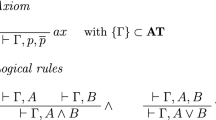Abstract
We denote by C *k the formula
. In this paper for all k there is constructed a derivation of C *k with cut, the number of sequents in which depends linearly on k. On the other hand, it is impossible to give an upper bound which is a Kalmar elementary function of k for the number of sequents in any derivation of the formula C *k without cuts, or for the number of disjunctions in a refutation by the method of resolutions of systems of disjunctions corresponding to the negation of the formula C *k . In particular, one can construct a derivation with cut of the formula C *6 , in which there is contained no more than 253 sequents, but in seeking a derivation of C *6 by the method of resolutions it is necessary to construct more than 1019200 disjunctions. With the help of Skolemization and taking out of quantifiers with respect to the formula C *k there is constructed a formula ∃v0B +k (v0), which satisfies the following conditions: 1) one can construct a derivation with cuts of the formula ∃v0B +k (v0) in the constructive predicate calculus, the number of sequents in which depends linearly on k; 2) it is impossible to give an upper bound which is a Kalmar elementary function of k of the length of a term t such that the formula B +k (t) is derivable.
Similar content being viewed by others
Literature cited
G. S. Tseitin, “Complexity of a derivation in the prepositional calculus,” Zap. Nauchn. Sem. Leningr. Otd. Mat. Inst. Akad. Nauk SSSR,8, 234–259 (1968).
Z. Galil, “On enumeration procedures for theorem proving and for integer programming,” in: Automata Languages and Programming, Edinburgh (1977), pp. 355–381.
R. Statman, “The predicate calculus is not a Kalmar elementary speed-up of the equation calculus,” Preprint, Cambridge (1975).
S. C. Kleene, Mathematical Logic, New York (1967).
G. Gentzen, “Untersuchungen über das logische Schliessen,” Math. Z.,39, 176–210, 405–433 (1934).
S. C. Kleene, Introduction to Metamathematics, Amsterdam (1952).
H. B. Curry, Foundations of Mathematical Logic, New York (1963).
R. Peter, Rekursive Funktionen, Budapest (1951).
J. A. Robinson, “A machine-oriented logic based on the resolution principle,” J. Assoc. Comput. Mach.,12, No. 1, 23–41 (1965).
G. V. Davydov, S. Yu. Maslov, G. E. Mints, V. P. Orevkov, and A. O. Slisenko, “Machine algorithms for establishing derivability on the basis of the inverse method,” Zap. Nauchn. Sem. Leningr. Otd. Mat. Inst. Akad. Nauk SSSR,16, 8–19 (1969).
J. A. Robinson, “Automatic deduction with hyperresolution,” Int. J. Comput. Mach.,1, 227–234.
Additional information
Translated from Zapiski Nauchnykh Seminarov Leningradskogo Otdeleniya Matematicheskogo Instituta im. V. A. Steklova AN SSSR, Vol. 88, pp. 137–161, 1979.
Rights and permissions
About this article
Cite this article
Orevkov, V.P. Lower bounds for increasing complexity of derivations after cut elimination. J Math Sci 20, 2337–2350 (1982). https://doi.org/10.1007/BF01629444
Received:
Issue Date:
DOI: https://doi.org/10.1007/BF01629444



